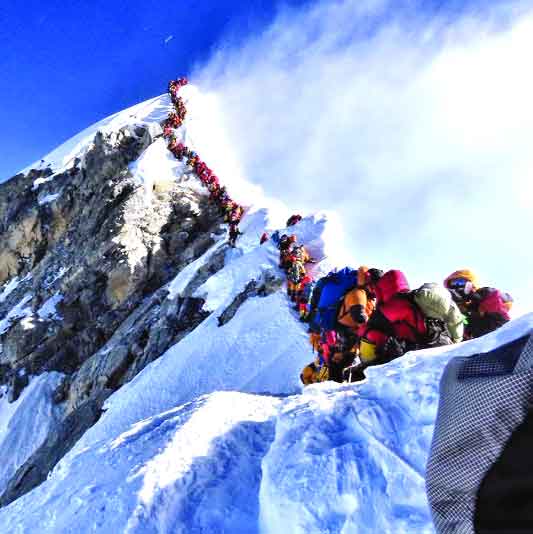Two Indians died on Mount Everest due to hours-long “traffic jam”, just days after expedition leaders and the Nepal Government claimed overcrowding on the world’s tallest mountain was not a worry.
Indian climber Kalpana Das, 49, reached the summit, but died on Thursday afternoon while descending as a large number of climbers queued near the top. She was a member of the “Three Women Expedition”, Gyanendra Shrestha, a liaison officer at the Everest base camp, was cited as saying by the Himalayan Times.
Another Indian climber, 27-year-old Nihal Bagwan from Maharashtra, died on his return from the summit. Babu Sherpa, managing director at Peak Promotion Pvt Ltd, said Bagwan breathed his last at Camp IV on Everest on the Nepal side after he was rescued by a group of Sherpas.
“The climber died at Camp IV after he fell ill near the balcony area while returning from the summit,” Sherpa said and added Bagwan was the leader of a two-member expedition.
Their deaths were attributed primarily to a long queue of both ascending and descending climbers, forcing many to wait for hours at 8,000 metres plus altitudes.
A 65-year-old Austrian climber, meanwhile, died on the northern Tibet side of the mountain. Earlier this week, Anjali Kulkarni (India), 55, and Donald Lynn Cash (USA), 55, died on the mountain. The woman’s expedition agency, Arun Treks and Expeditions, said she died of “exhaustion”.
The American climber died while descending from the summit, 15 metres below the Hillary Step, which stands at 8,790 metres. “He died of altitude sickness as he had lost energy,” said Pasang Tenje Sherpa, chairman of Pioneer Adventure, the climber’s expedition agency.
Indian climber Ravi Thakar died while returning from the summit last week.
A “traffic jam” occurs on Everest when many climbers vie for the summit at the same time and it can be especially dangerous above 8,000 metres, called the “Death Zone”.
The last steep challenge before the summit occurs after the Hillary Step — a vertical rock face at 8,790 metres — which many climbers said was dislodged in the 2015 earthquake. In a “traffic jam”, exhausted climbers are often forced to wait for several hours for their turn to ascend or descend on a single rope, increasing risks of exhaustion, frostbite or altitude sickness.
The number of Everest climbers in 2019 may exceed last year’s record of 807.

























